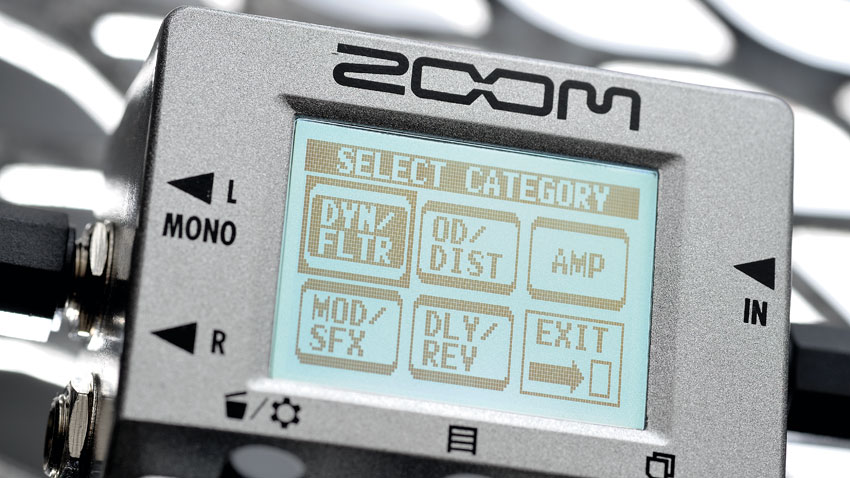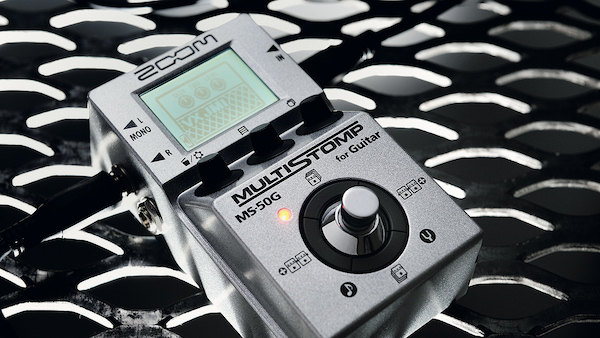MusicRadar Verdict
Having Zoom's multi-effects in a compact form factor could provide the most practical chameleon pedal so far.
Pros
- +
Compact size. Wide range of effects. Multiple or single effects both possible.
Cons
- -
Power adaptor not supplied.
MusicRadar's got your back

Zoom MS-50G MultiStomp

Zoom MS-50G MultiStomp (screen)
There has been a trend among manufacturers to minimise the size of their stompboxes to allow users to put together smaller pedalboards, or simply cram more pedals into the available space - the Electro-Harmonix Nano series or the Red Witch Seven Sisters come to mind.
"Zoom claims that the MS-50G is the first of its kind, packing a multi-effects pedal and amp modeller into a single-sized stompbox"
Zoom could be seen as the latest company to join this trend, not so much that it has created a pedal with a smaller-than-standard footprint (the MS-50G is actually marginally larger than a Boss compact), but more what they have actually crammed into a pedal of that size. In fact, Zoom claims that the MS-50G is the first of its kind, packing a multi-effects pedal and amp modeller into a single-sized stompbox.
What you get with the MS-50G is a pedal packed with 55 different sounds (47 effects and eight amp models), six of which can be used simultaneously in any order. Add a chromatic tuner into the equation, and you're looking at a pedal for all seasons.
With the facilities onboard, it comes as no surprise that the MS-50G won't run from a standard PP3 battery; instead, it takes a pair of AA batteries, which are supplied with the pedal and should give up to seven hours of use. It will run from a nine-volt adaptor, but it needs one that can put out 500mA, such as Zoom's AD-16.
"The footswitch is surrounded by a four-way cursor that lets you navigate around the screen"
The MS-50G is solidly built, with a silver diecast body, three knobs and a footswitch. It may look like many other small pedals, but the physical similarities stop there. The first difference is a neat 4x3mm LCD display, while the second is that the footswitch is surrounded by a four-way cursor that lets you navigate around the screen. The three knobs are actually soft knobs that can be pressed to call up particular menus and turned to adjust parameters.
The sounds in the MS-50G are stored in a total of 50 patch memories. The first 30 come with sounds pre-programmed at the factory, but all can be overwritten. Pressing the central control knob calls up the patch list, and you can turn the control to scroll through and select patches.
Each patch can be constructed from a chain of six effects blocks, each with a modelled amp or effect, DSP permitting - some effects are hungrier for DSP than others, so not all combinations are possible.
Editing your sounds is pretty straightforward once you've got used to the knobs and cursors: the horizontal cursors scroll left and right through the blocks in the chain, while the vertical cursors can scroll through all of the amps and effects to select one for the block.
"Each amp or effect has editable parameters displayed three at a time on the screen and adjusted with the three knobs"
Each amp or effect has editable parameters displayed three at a time on the screen and adjusted with the three knobs. If there are more than three editable parameters, you simply press the third knob to move to the next page. All changes are automatically saved by default, although you can switch to manual saving if preferred.
In practice, if you want, say, an auto-wah for one song and a phaser for the next, you will have them saved as patches (possibly consecutively numbered ones for ease), meaning you can simply bend down and press the centre knob, scroll to the desired patch and press the knob again.
However, Zoom has also included a facility whereby you can cycle through them in order using the footswitch. A letter is easily assigned to each patch, and the footswitch will cycle through them in alphabetical order, so you can just assign the letters A and B and switch between two patches, or assign more letters to have up to 26 effects in succession.
Be aware, though, that in this mode (simply called up by pressing the centre knob so the patch list is in the display), the effect bypass function of the footswitch will be out of use, so you'll be going from one active effect to the next.
Rounding off the feature list, holding the footswitch down calls up an automatic chromatic tuner that can be switched to recognise several altered tunings. Alternatively, you can set the footswitch up for tap tempo. There's also a USB connection for firmware updates, which should ensure that the MS-50G stays current.
Sounds
The models in the MS-50G appear to be a cut-down set of those found in the G3 and G5. The very playable amp models cover the popular options: there are three Fenders ('65 Twin Reverb, '65 Deluxe Reverb, Tweed Bassman), a Vox AC30 and a Marshall Plexi. You also get a Two-Rock Emerald 50, while a Diezel Herbert and Engl Invader cover the high-gain side of things.
"Effects include modulation, filter, pitch shift, distortion, delay and reverb, some of which are modelled on well-known devices"
Effects include modulation, filter, pitch shift, distortion, delay and reverb. Most are generic, but some, particularly in the overdrive/distortion category, are modelled on well-known devices - the Big Muff and TS-808, for example.
You can put together some cool composite sounds built from several blocks, but while a combination of effects will be useful for some users looking to create something complex and original, others will be happy to have just a single effect in each patch slot. Few would probably choose the overdrives and distortions here over the real analogue thing, but they can still add colour when needed.
The rest of the effects provide a wide-ranging selection of standalone sounds that could sit side by side with your existing pedal set; we can see the MS-50G easily slotting into the role of a supplementary element on your pedalboard.
If you'd like to use a different type of modulation for a number of songs in your set but don't have the space to put phaser, flanger, chorus and tremolo pedals on your 'board, the MS-50G could be the answer.
With a street price of just under £100, the MS-50G has to be one of the bargains of the guitar year so far. While not all of the sounds are going to appeal to all players, there are enough usable tones here to make this a very practical item for just about anybody who uses effects.
There are other chameleon pedals around, but the Zoom has some practical advantages that should ensure its popularity, most notably its compact size and the ability to set up patches that use up to six effects, as well as its sub-£100 price tag. As an affordable multi-role secret weapon for your 'board, it's in a class of its own.
Trevor Curwen has played guitar for several decades – he's also mimed it on the UK's Top of the Pops. Much of his working life, though, has been spent behind the mixing desk, during which time he has built up a solid collection of the guitars, amps and pedals needed to cover just about any studio session. He writes pedal reviews for Guitarist and has contributed to Total Guitar, MusicRadar and Future Music among others.
“Excels at unique modulated timbres, atonal drones and microtonal sequences that reinvent themselves each time you dare to touch the synth”: Soma Laboratories Lyra-4 review
“I used everything I knew about music”: How Green Day exceeded expectations with their most ambitious song
YouTube just added AI tools that makes musicians, library music and video editors redundant











